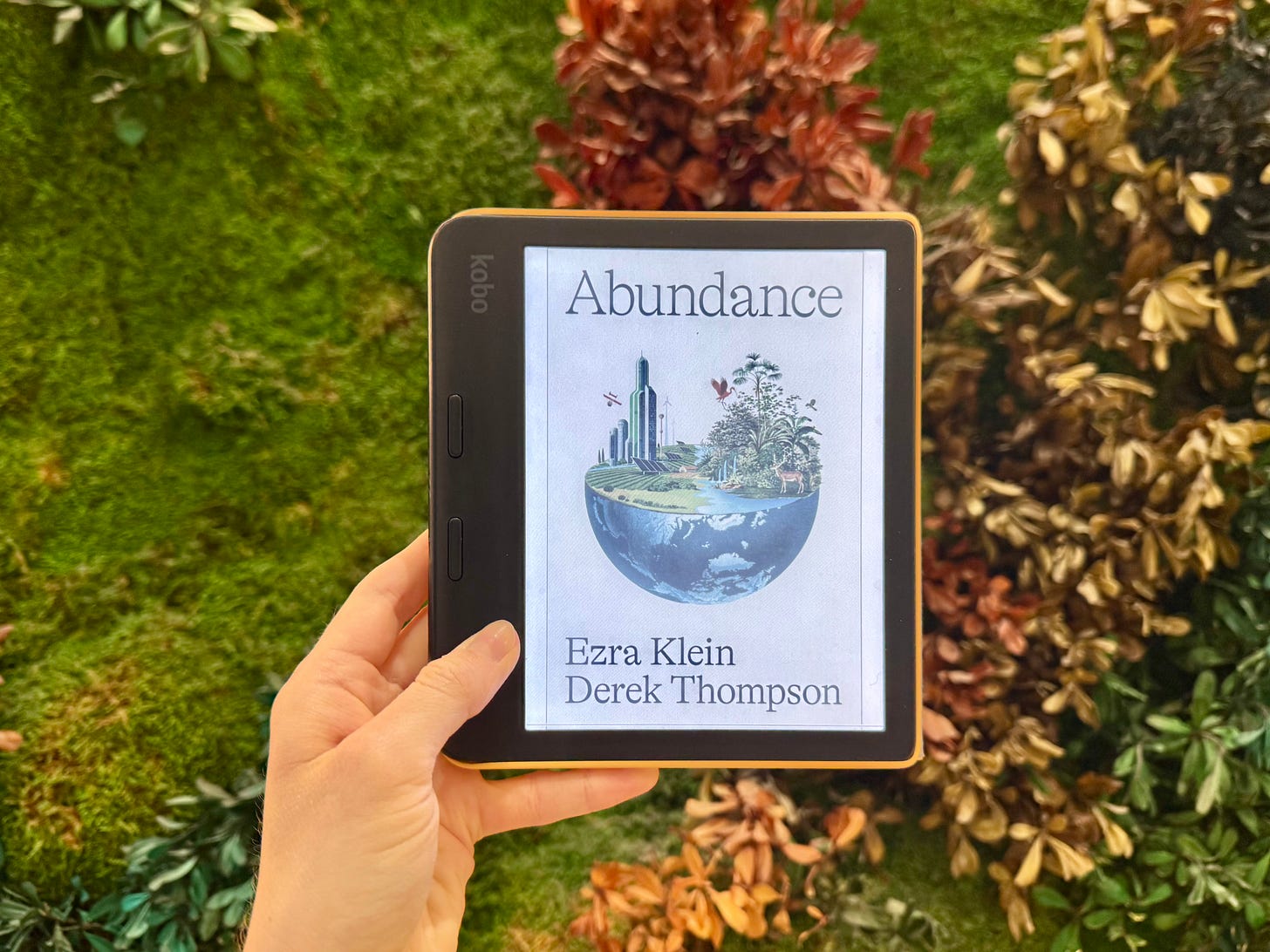Abundance: What does it actually mean?
A recap of Ezra Klein and Derek Thompson's divisive new book, Abundance, and the debate it has sparked
On March 18 — release date — I downloaded Ezra Klein’s and Derek Thompson’s new book Abundance to my Kobo. Despite being in a foreign country with no access to English-language new releases, in a couple of clicks, I had in my hand what friends in New York, London, and Melbourne were all also reading at the same time. It’s astounding, really, that we’re not more astounded by this.
Getting the book was the simple part. The complicated part was wading through all the online debate the book sparked, which began basically on release date (really, how many people had actually finished the book before lunchtime on release day?).
The major basis for the debate seems to be a real confusion about what an Abundance Agenda actually is and a belief that it divides centrist liberals from their more left-wing counterparts. Here I agree wholeheartedly with Noahpinion’s claim that “most of the progressive critics of the abundance idea appear not to have actually read Klein and Thompson’s book.” Why read the source material when you could angrily inhale a Tweet thread instead?
So let’s clarify:
What actually is the Abundance Agenda?
Klein and Thompson propose abundance as the opposite of scarcity: more instead of less. The Right loves to scare people into submission using scarcity, “but blue America practices its own version of scarcity politics,” say the authors, like zoning regulations that throttle housing supply and idealistic visions of degrowth. The Abundance Agenda is not about deregulation, privatization, or smaller governments: it is fundamentally about build government capacity. “Whether government is bigger or smaller is the wrong question,” say the authors. “What it needs to be is better.”
Basically, an Abundance Agenda focuses on outcomes over process. I like Noahpinion’s explanation:
If deregulation produces more housing, then deregulate. If building more social housing produces more housing, then build more social housing. Why not both? The point is not what legal philosophy you embrace in order to get more housing. The point is that you get the housing.
Klein and Thompson advocate for a well-funded, capable government that uses its money and authority to solve big problems fast. In some cases, this might mean getting government out of the way, but in many cases, it means putting government to work. The authors in no way believe the free market will solve our problems. Take the climate crisis, for example. Many believe the private sector holds the keys to climate action. Klein and Thompson don’t:
“The market cannot, on its own, distinguish between the riches that flow from burning coal and the wealth that is created by bettering battery storage. Government can.”
But the authors also criticize a government that gets in its own way. That’s basically the government we have today, one that is hobbled by decades of mostly well-meaning attempts by liberals to block abuses of power and environmental destruction. But “one generation’s solutions can become the next generation’s problems,” the authors argue. A government buried in yesterday’s bureaucracy, no matter how well-intended, cannot adequately address the problems of today.
Abundance is like a Get Things Done manual for the US government, or a Lean Startup approach for a dinosaur company that has forgotten how to move.
Alright, that’s the basics covered. Let’s explore the book in more detail. The book is neatly divided into five key parts.
1 — Grow
Degrowth is revered among many liberals, and I’ve written about it myself. As the authors note, there is something inherently appealing and logical in the idea of stripping back modern life, getting rid of the fast fashion and the junk food aisles and all the things that disgust us about modern life. But the problem, the authors note, is that even if degrowth was suddenly embraced by all, it can’t happen fast enough to fix our problems.
The other problem with degrowth is that even this vision actually requires some kind of growth. If you want heat in a Minnesota winter, then we’ll need more heat pumps. If you want everyone to stop driving, then we’ll need better inner city transport. You get the idea.
Housing supply is the main focus of this chapter: namely, that we need a ton more of it to correct the egregious inequalities in the current housing market. The kicker here is that despite what liberals say about housing equality, blue states have the worst housing crises thanks to Liberal-backed zoning laws. This is not just a moral failure for the Democrats; it’s also an existential crisis. More and more young liberals are making the tough choice to leave places like New York and Los Angeles to smaller cities in red states, where more houses are built more frequently and with less fuss. If the Democrats lose their urban bases, more blue states will turn red.
A small grievance: although the focus of this chapter is on making more, I do wish the authors had acknowledged the damaging role of corporate investment and private equity in the housing crisis. They are quick to point the finger at liberal zoning laws, but never once mention the tragedy of corporate America’s appetite for single family homes.
2 — Build
I’m still a little stuck on the difference between grow and build here, but no matter. In this chapter, Klein and Thompson explain how the rise of the environmental movement in the late twentieth century led to a liberal approach to government that focused on blocking rather than building.
In its historical context, this often made sense. New factories did pollute local communities. Highways would destroy critical natural environments. Even today, we do need mechanisms to block unnecessary and potentially harmful developments — like, say, new oil pipelines. But even the liberal environmental agenda (clear skies, clean rivers, more forests) can’t get off the ground without major investment in actually building things.
A true net-zero transition will require one of the biggest engineering and manufacturing efforts in history. We need solar panels, wind turbines, nuclear power plants and waste facilities, high-speed rail, inner city transportation, electric car charging stations, direct air capture, some kind of solution for aviation — the list is endless.
And that’s just mitigation! The authors don’t even get into everything we’d need to build in order to adapt to the realities of climate change that are already on their way, like rising sea levels and natural disasters.
A fair and climate-mitigated and climate-adapted future requires more than just stopping negative developments. We can’t block or de-growth our way there. We’ll have to start saying ‘yes’ more.


3 — Govern
One of the most interesting chapters in the book. This section focuses on state capacity: the ability of the state to achieve its goals. Sometimes that requires more government, say the authors, and sometimes it requires less. The key point here is that state capacity is something both sides seem to have forgotten that the ultimate goal of government is to enable — a goal it is miserably failing at.
In theory, the US government is a powerful force. Yet the presence of government these days almost always leads to enormous delays and frustrating bureaucratic due process. We’ve come to accept government inadequacy as the norm, but it makes little sense. “Shouldn’t things happen faster when they are backed by the might and money of the government?” Klein and Thompson ask.
It’s not just the legal mechanisms designed to stall or block government action that are fettering state capacity — it’s also too many good intentions. “One problem liberals are facing at every level where they govern is that they often add too many goals to a single project,” the authors complain, citing important initiatives like the CHIPS and Science Act (an initiative to bring semiconductor manufacturing home) that were unnecessarily slowed by well-meaning government policies. Applicants to the initiative were inundated with stringent guidelines and endless reporting requirements (including questions about how they would include small, minority-, veteran- and female-owned businesses in their supply chains), environmental reviews, and more.
Are these requirements or suggestions well-intended? Absolutely. Do they help advance the goal? Not always, and not in urgent national security initiatives like the CHIPS bill.
An abundance agenda requires a government that understands how to focus: how to make strategic tradeoffs — sometimes between issues, sometimes between the short-term and the long-term — in order to get things done now. It’s sort of a done is better than perfect approach to government. We’ve spent too long watching things not get done (and certainly not be perfect). “In the absence of focus, absurdity reigns,” the authors quip.
4 — Invent
“The world is filled with problems we cannot solve without more invention,” Klein and Thompson argue. Those who argue with this (and there are many, especially in my field of climate change, who do) are living in La La Land. We do need more and better technologies to reverse climate change, save lives, and reduce suffering. If we truly want to live in an abundant world, we may not need more miniskirts (do people wear them anymore?) or PlayStations, but we absolutely need more scientific breakthroughs and more technological innovation.
This chapter focuses intently on how the US government has become increasingly risk-averse in its funding for scientific research, leading to overwhelmed scientists and underwhelming science. We’re seeing fewer important breakthroughs, which is turning our current era into one where scientific and technological progress has slowed to a virtual trickle. According to the authors, “neither [side] have prioritized the rigorous analysis of public policy in sciences.” Liberals talk about “science” a lot, and are rightly devastated by Trump’s battering-ram approach to anything remotely scientific — but are they also turning a blind eye to the non-partisan factors that have already stifled decades of scientific progress in the US today?
It also introduces an important argument for selective immigration to advance national scientific and technological progress, something I hope my own country (listen up, Australia!) is thinking about as the Trump administration cracks down hard on immigration in any form. Australians could see this as a gift from the man in the red hat himself: with the US shutting its doors, genius-level IQs all over the world are looking for somewhere to take their talents. Why not welcome them with open arms?
5 — Deploy
Retelling the underlooked success of Operation Warp Speed, this chapter explores how government intervention could and should help deliver fast, large-scale outcomes for its people. “The state is no enemy of invention or innovation,” the authors argue. “In fact, the government can accelerate both.” To solve our current problems, we need a capable government, not a government crippled by insufficient funds, overwhelming process requirements, or legal blocking mechanisms.
What does deploy really mean? Here, the authors quote John Arnold, the cochair of Arnold Ventures philanthropy: “America has the ability to invent. China has the ability to build. The first country that can figure out how to do both will be the superpower.”
For too long, America has watched in awe and fear as China builds hospitals, highways and all manner of infrastructure in days rather than decades. Yet the US government can build quickly too, when it’s allowed to, like the rebuilding of Philadelphia’s I-95 bridge in 2023, which thanks to an emergency declaration, took just twelve days. I think this is where things get tricky, especially given our polarized politics today. We’re talking about loosening bureaucracy to build houses and solar farms. Would we be happy for the Right to have the same powers? (Not that they appear at all concerned with what they are ‘allowed’ to do…)
The critical point here is that if the US doesn’t learn how to deploy, other countries will. The authors use energy-hungry data centres as an example. If companies begin looking elsewhere for a practical solution to their energy needs, what does this mean for the US? Does America really want its data centres in the Middle East? Well then — build something about it.
Why don’t people want abundance?
Alright, that’s the book recapped. Now let’s get to why it’s gotten some people so riled up. We’ll start with one of the key sentiments I’ve seen floating around on Substack:
Basically, the degrowth argument: we don’t need anything new. I won’t spend too much time here, because it doesn’t require much time to rebut. We do need to invent and build and deploy new things. We need a cure for cancer, and a clean energy infrastructure, and more homes for people to live in.
In a similar vein, many progressive critics have pit the authors as centrists against the supposedly more radical Warren/Bernie/AOC agenda. Noahpinion’s review explores the ‘class resentment’ toward abundance in more detail, outlining how many on the Left appear unable to accept an agenda that isn’t outrightly hostile to corporate America and the billionaire class.
Klein and Thompson do stay fairly fainbows and butterflies about their Abundance Agenda, going for more of a ‘rising tide lifts all’ than a ‘billionaires should be banned’ approach, but in my opinion, Abundance need not butt heads with a more Leftist agenda. An abundant government needs, well, an abundance of funds. Why not get that from the billionaires? An abundant government will likely need to work with the private sector to get things done — but that doesn’t mean they can’t also enforce strong antitrust policies.
The main question that I felt the book didn’t answer for me was around partisan politics. Maybe at the city and state level we’ll see abundance at work successfully. But how does an Abundance Agenda work over the long term and at the federal level, when the White House changes colour every four years? Does a more capable government with a liberal agenda also translate to a more capable government with a conservative agenda?
I don’t know the answers to these questions, but I did feel like the book missed an opportunity to weigh in on this obvious concern.
Overall: if you’re frustrated by liberal politics and unsure what a better future even looks like, give Abundance a read! The only problem is you’ll be left feeling inspired about what could be possible, and then look up from your book only to remember that — well — an Abundance Agenda feels like a faraway dream for now.




